Examining the American Economic Collapse: A Critical Perspective
VerifiedAdded on 2023/06/10
|7
|1623
|167
Essay
AI Summary
This essay critically analyzes the role of capitalism in the collapse of the American economic system, drawing upon theoretical perspectives discussed in class and outlined in the text. It examines Michael Parenti's article, focusing on the misconceptions and lack of awareness surrounding capitalism's malfunctions. The analysis highlights the conflicting interests between capitalists and the ideals of democracy, the government's bias towards capitalist interests, and the problems inherent in a laissez-faire economy, such as overproduction, under-consumption, and the prioritization of capitalist well-being over basic human rights. The essay concludes that the collapse is attributed to a lack of awareness and the failure of business owners to adhere to democratic principles, resulting in an unstable American economic system. Desklib offers similar solved assignments and past papers for students.
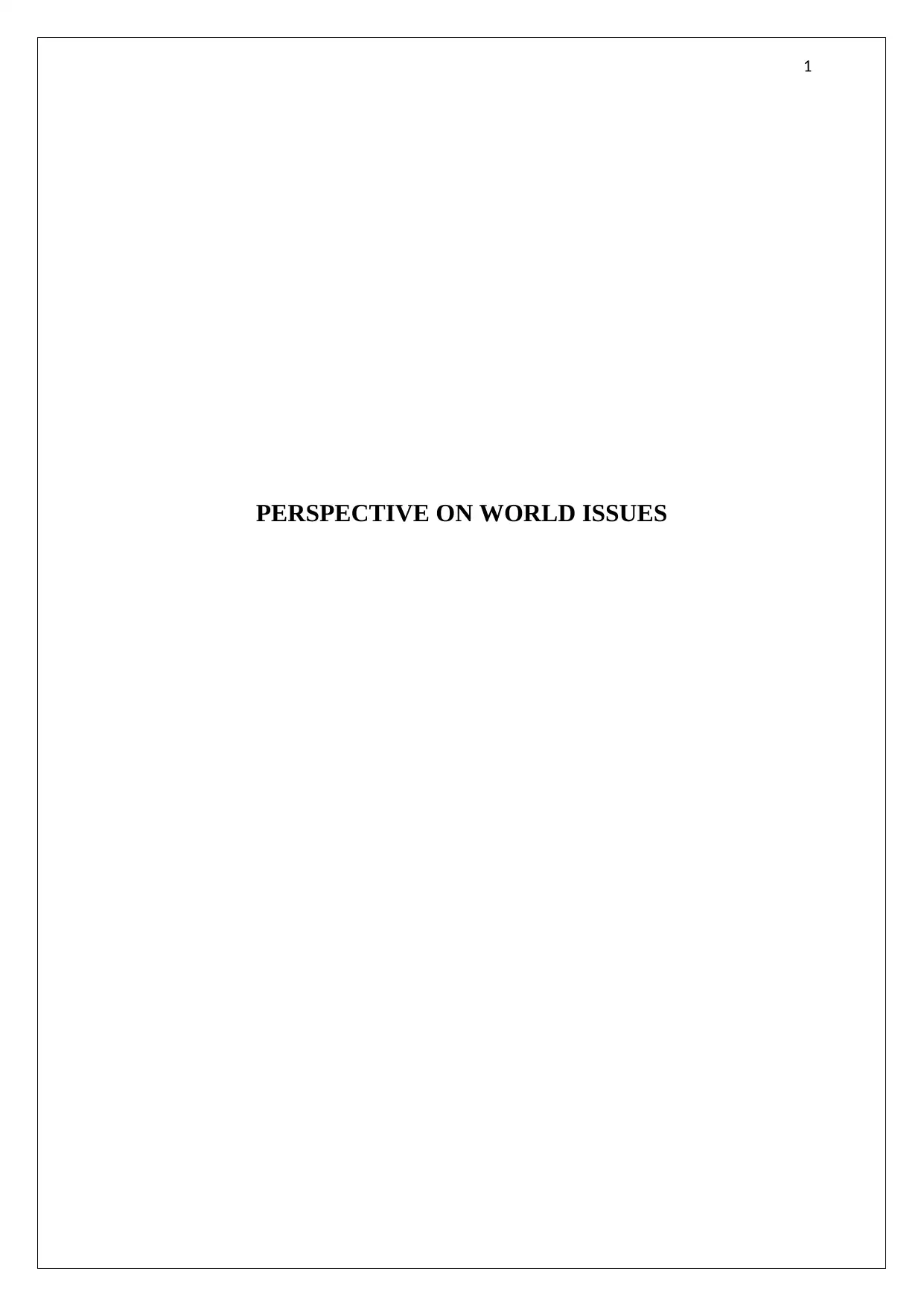
1
PERSPECTIVE ON WORLD ISSUES
PERSPECTIVE ON WORLD ISSUES
Paraphrase This Document
Need a fresh take? Get an instant paraphrase of this document with our AI Paraphraser
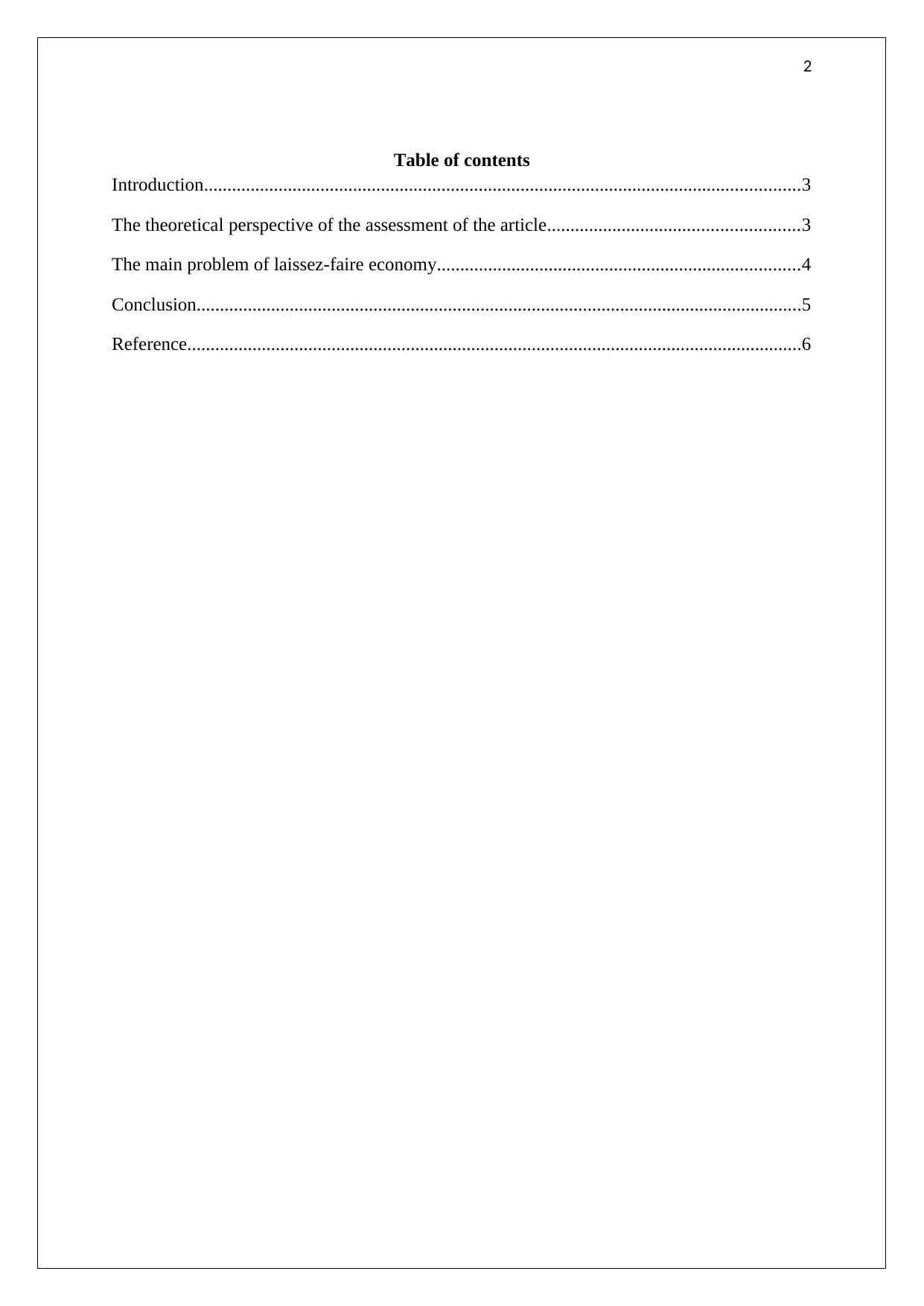
2
Table of contents
Introduction................................................................................................................................3
The theoretical perspective of the assessment of the article......................................................3
The main problem of laissez-faire economy..............................................................................4
Conclusion..................................................................................................................................5
Reference....................................................................................................................................6
Table of contents
Introduction................................................................................................................................3
The theoretical perspective of the assessment of the article......................................................3
The main problem of laissez-faire economy..............................................................................4
Conclusion..................................................................................................................................5
Reference....................................................................................................................................6
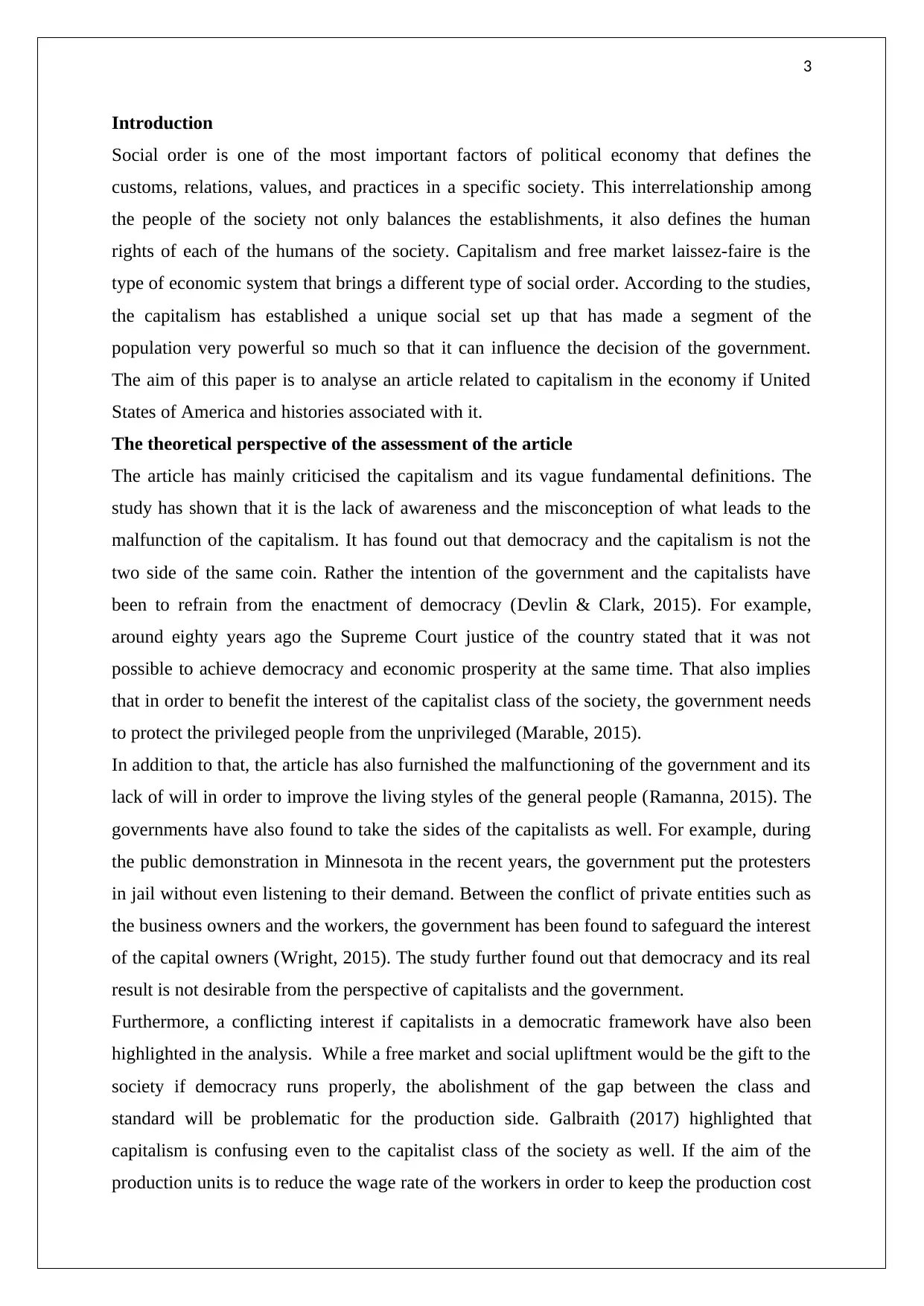
3
Introduction
Social order is one of the most important factors of political economy that defines the
customs, relations, values, and practices in a specific society. This interrelationship among
the people of the society not only balances the establishments, it also defines the human
rights of each of the humans of the society. Capitalism and free market laissez-faire is the
type of economic system that brings a different type of social order. According to the studies,
the capitalism has established a unique social set up that has made a segment of the
population very powerful so much so that it can influence the decision of the government.
The aim of this paper is to analyse an article related to capitalism in the economy if United
States of America and histories associated with it.
The theoretical perspective of the assessment of the article
The article has mainly criticised the capitalism and its vague fundamental definitions. The
study has shown that it is the lack of awareness and the misconception of what leads to the
malfunction of the capitalism. It has found out that democracy and the capitalism is not the
two side of the same coin. Rather the intention of the government and the capitalists have
been to refrain from the enactment of democracy (Devlin & Clark, 2015). For example,
around eighty years ago the Supreme Court justice of the country stated that it was not
possible to achieve democracy and economic prosperity at the same time. That also implies
that in order to benefit the interest of the capitalist class of the society, the government needs
to protect the privileged people from the unprivileged (Marable, 2015).
In addition to that, the article has also furnished the malfunctioning of the government and its
lack of will in order to improve the living styles of the general people (Ramanna, 2015). The
governments have also found to take the sides of the capitalists as well. For example, during
the public demonstration in Minnesota in the recent years, the government put the protesters
in jail without even listening to their demand. Between the conflict of private entities such as
the business owners and the workers, the government has been found to safeguard the interest
of the capital owners (Wright, 2015). The study further found out that democracy and its real
result is not desirable from the perspective of capitalists and the government.
Furthermore, a conflicting interest if capitalists in a democratic framework have also been
highlighted in the analysis. While a free market and social upliftment would be the gift to the
society if democracy runs properly, the abolishment of the gap between the class and
standard will be problematic for the production side. Galbraith (2017) highlighted that
capitalism is confusing even to the capitalist class of the society as well. If the aim of the
production units is to reduce the wage rate of the workers in order to keep the production cost
Introduction
Social order is one of the most important factors of political economy that defines the
customs, relations, values, and practices in a specific society. This interrelationship among
the people of the society not only balances the establishments, it also defines the human
rights of each of the humans of the society. Capitalism and free market laissez-faire is the
type of economic system that brings a different type of social order. According to the studies,
the capitalism has established a unique social set up that has made a segment of the
population very powerful so much so that it can influence the decision of the government.
The aim of this paper is to analyse an article related to capitalism in the economy if United
States of America and histories associated with it.
The theoretical perspective of the assessment of the article
The article has mainly criticised the capitalism and its vague fundamental definitions. The
study has shown that it is the lack of awareness and the misconception of what leads to the
malfunction of the capitalism. It has found out that democracy and the capitalism is not the
two side of the same coin. Rather the intention of the government and the capitalists have
been to refrain from the enactment of democracy (Devlin & Clark, 2015). For example,
around eighty years ago the Supreme Court justice of the country stated that it was not
possible to achieve democracy and economic prosperity at the same time. That also implies
that in order to benefit the interest of the capitalist class of the society, the government needs
to protect the privileged people from the unprivileged (Marable, 2015).
In addition to that, the article has also furnished the malfunctioning of the government and its
lack of will in order to improve the living styles of the general people (Ramanna, 2015). The
governments have also found to take the sides of the capitalists as well. For example, during
the public demonstration in Minnesota in the recent years, the government put the protesters
in jail without even listening to their demand. Between the conflict of private entities such as
the business owners and the workers, the government has been found to safeguard the interest
of the capital owners (Wright, 2015). The study further found out that democracy and its real
result is not desirable from the perspective of capitalists and the government.
Furthermore, a conflicting interest if capitalists in a democratic framework have also been
highlighted in the analysis. While a free market and social upliftment would be the gift to the
society if democracy runs properly, the abolishment of the gap between the class and
standard will be problematic for the production side. Galbraith (2017) highlighted that
capitalism is confusing even to the capitalist class of the society as well. If the aim of the
production units is to reduce the wage rate of the workers in order to keep the production cost
⊘ This is a preview!⊘
Do you want full access?
Subscribe today to unlock all pages.

Trusted by 1+ million students worldwide
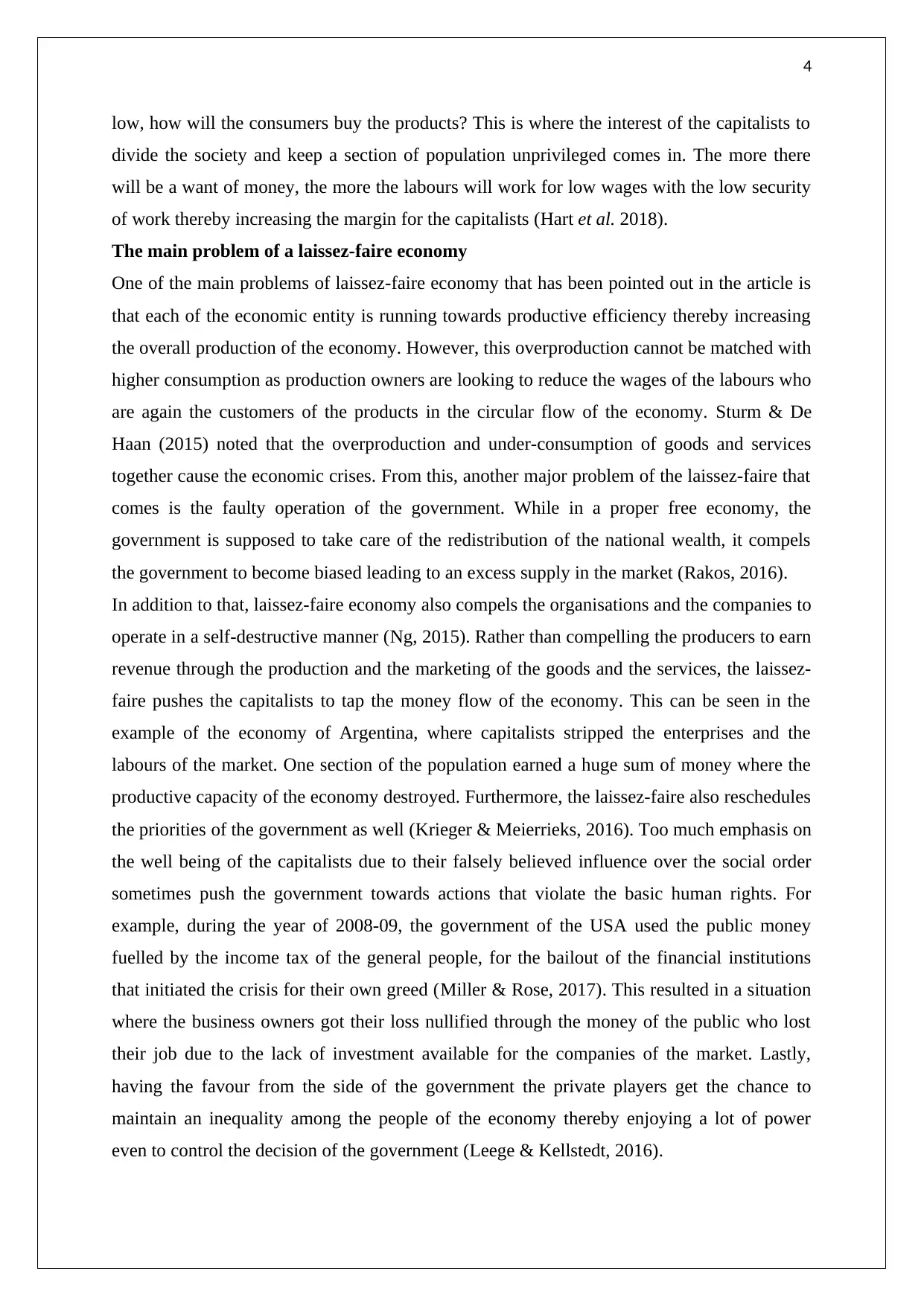
4
low, how will the consumers buy the products? This is where the interest of the capitalists to
divide the society and keep a section of population unprivileged comes in. The more there
will be a want of money, the more the labours will work for low wages with the low security
of work thereby increasing the margin for the capitalists (Hart et al. 2018).
The main problem of a laissez-faire economy
One of the main problems of laissez-faire economy that has been pointed out in the article is
that each of the economic entity is running towards productive efficiency thereby increasing
the overall production of the economy. However, this overproduction cannot be matched with
higher consumption as production owners are looking to reduce the wages of the labours who
are again the customers of the products in the circular flow of the economy. Sturm & De
Haan (2015) noted that the overproduction and under-consumption of goods and services
together cause the economic crises. From this, another major problem of the laissez-faire that
comes is the faulty operation of the government. While in a proper free economy, the
government is supposed to take care of the redistribution of the national wealth, it compels
the government to become biased leading to an excess supply in the market (Rakos, 2016).
In addition to that, laissez-faire economy also compels the organisations and the companies to
operate in a self-destructive manner (Ng, 2015). Rather than compelling the producers to earn
revenue through the production and the marketing of the goods and the services, the laissez-
faire pushes the capitalists to tap the money flow of the economy. This can be seen in the
example of the economy of Argentina, where capitalists stripped the enterprises and the
labours of the market. One section of the population earned a huge sum of money where the
productive capacity of the economy destroyed. Furthermore, the laissez-faire also reschedules
the priorities of the government as well (Krieger & Meierrieks, 2016). Too much emphasis on
the well being of the capitalists due to their falsely believed influence over the social order
sometimes push the government towards actions that violate the basic human rights. For
example, during the year of 2008-09, the government of the USA used the public money
fuelled by the income tax of the general people, for the bailout of the financial institutions
that initiated the crisis for their own greed (Miller & Rose, 2017). This resulted in a situation
where the business owners got their loss nullified through the money of the public who lost
their job due to the lack of investment available for the companies of the market. Lastly,
having the favour from the side of the government the private players get the chance to
maintain an inequality among the people of the economy thereby enjoying a lot of power
even to control the decision of the government (Leege & Kellstedt, 2016).
low, how will the consumers buy the products? This is where the interest of the capitalists to
divide the society and keep a section of population unprivileged comes in. The more there
will be a want of money, the more the labours will work for low wages with the low security
of work thereby increasing the margin for the capitalists (Hart et al. 2018).
The main problem of a laissez-faire economy
One of the main problems of laissez-faire economy that has been pointed out in the article is
that each of the economic entity is running towards productive efficiency thereby increasing
the overall production of the economy. However, this overproduction cannot be matched with
higher consumption as production owners are looking to reduce the wages of the labours who
are again the customers of the products in the circular flow of the economy. Sturm & De
Haan (2015) noted that the overproduction and under-consumption of goods and services
together cause the economic crises. From this, another major problem of the laissez-faire that
comes is the faulty operation of the government. While in a proper free economy, the
government is supposed to take care of the redistribution of the national wealth, it compels
the government to become biased leading to an excess supply in the market (Rakos, 2016).
In addition to that, laissez-faire economy also compels the organisations and the companies to
operate in a self-destructive manner (Ng, 2015). Rather than compelling the producers to earn
revenue through the production and the marketing of the goods and the services, the laissez-
faire pushes the capitalists to tap the money flow of the economy. This can be seen in the
example of the economy of Argentina, where capitalists stripped the enterprises and the
labours of the market. One section of the population earned a huge sum of money where the
productive capacity of the economy destroyed. Furthermore, the laissez-faire also reschedules
the priorities of the government as well (Krieger & Meierrieks, 2016). Too much emphasis on
the well being of the capitalists due to their falsely believed influence over the social order
sometimes push the government towards actions that violate the basic human rights. For
example, during the year of 2008-09, the government of the USA used the public money
fuelled by the income tax of the general people, for the bailout of the financial institutions
that initiated the crisis for their own greed (Miller & Rose, 2017). This resulted in a situation
where the business owners got their loss nullified through the money of the public who lost
their job due to the lack of investment available for the companies of the market. Lastly,
having the favour from the side of the government the private players get the chance to
maintain an inequality among the people of the economy thereby enjoying a lot of power
even to control the decision of the government (Leege & Kellstedt, 2016).
Paraphrase This Document
Need a fresh take? Get an instant paraphrase of this document with our AI Paraphraser
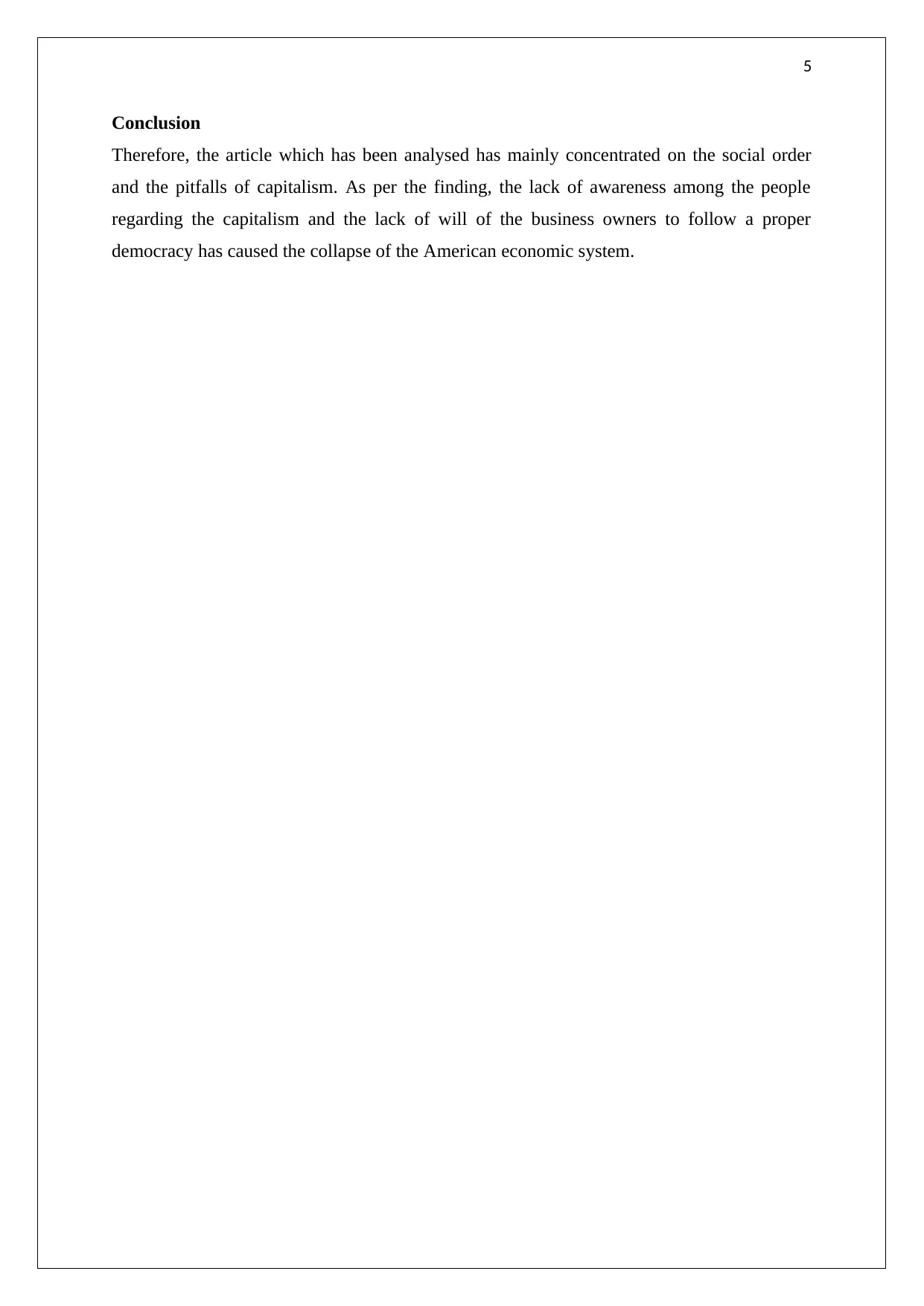
5
Conclusion
Therefore, the article which has been analysed has mainly concentrated on the social order
and the pitfalls of capitalism. As per the finding, the lack of awareness among the people
regarding the capitalism and the lack of will of the business owners to follow a proper
democracy has caused the collapse of the American economic system.
Conclusion
Therefore, the article which has been analysed has mainly concentrated on the social order
and the pitfalls of capitalism. As per the finding, the lack of awareness among the people
regarding the capitalism and the lack of will of the business owners to follow a proper
democracy has caused the collapse of the American economic system.
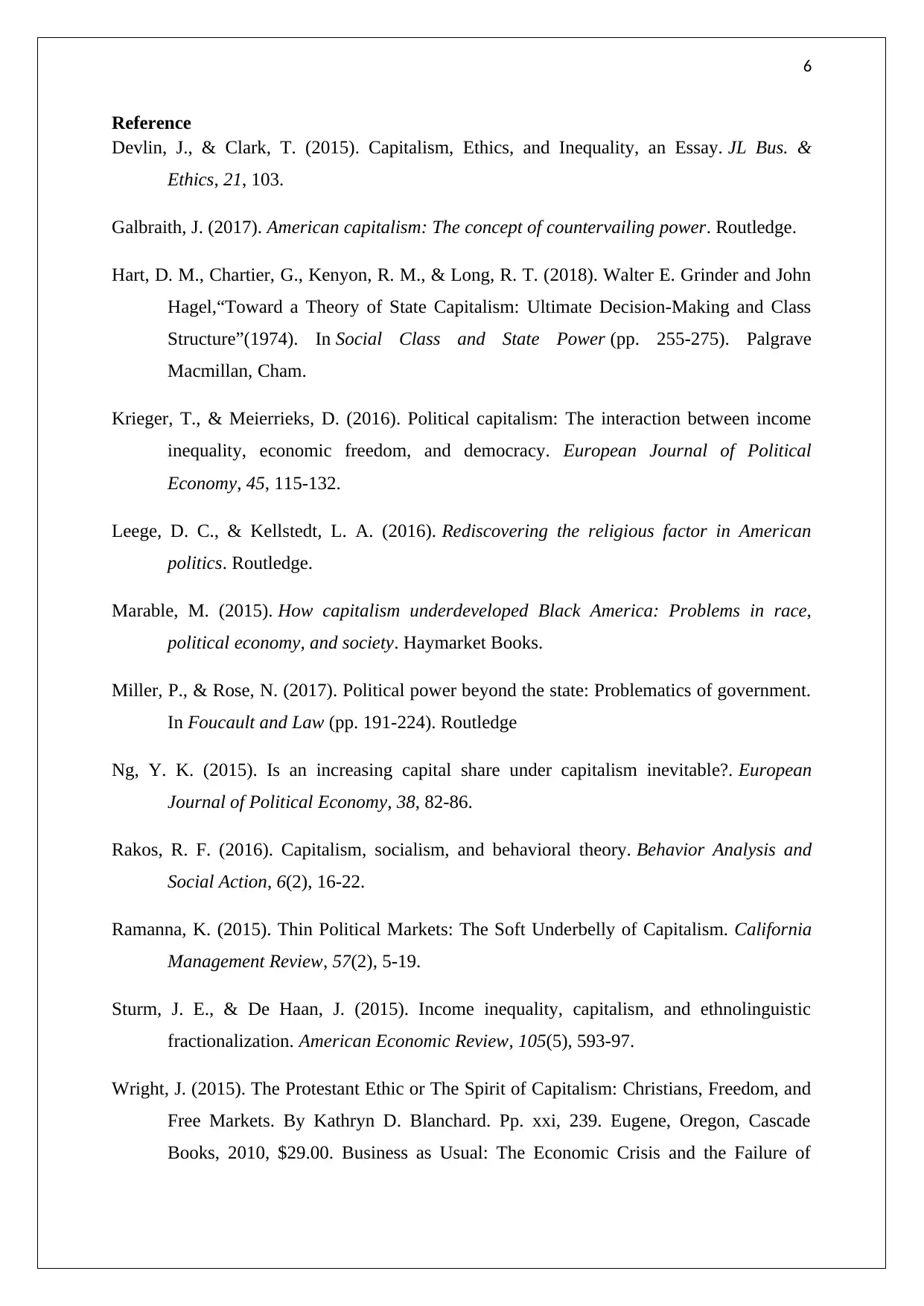
6
Reference
Devlin, J., & Clark, T. (2015). Capitalism, Ethics, and Inequality, an Essay. JL Bus. &
Ethics, 21, 103.
Galbraith, J. (2017). American capitalism: The concept of countervailing power. Routledge.
Hart, D. M., Chartier, G., Kenyon, R. M., & Long, R. T. (2018). Walter E. Grinder and John
Hagel,“Toward a Theory of State Capitalism: Ultimate Decision-Making and Class
Structure”(1974). In Social Class and State Power (pp. 255-275). Palgrave
Macmillan, Cham.
Krieger, T., & Meierrieks, D. (2016). Political capitalism: The interaction between income
inequality, economic freedom, and democracy. European Journal of Political
Economy, 45, 115-132.
Leege, D. C., & Kellstedt, L. A. (2016). Rediscovering the religious factor in American
politics. Routledge.
Marable, M. (2015). How capitalism underdeveloped Black America: Problems in race,
political economy, and society. Haymarket Books.
Miller, P., & Rose, N. (2017). Political power beyond the state: Problematics of government.
In Foucault and Law (pp. 191-224). Routledge
Ng, Y. K. (2015). Is an increasing capital share under capitalism inevitable?. European
Journal of Political Economy, 38, 82-86.
Rakos, R. F. (2016). Capitalism, socialism, and behavioral theory. Behavior Analysis and
Social Action, 6(2), 16-22.
Ramanna, K. (2015). Thin Political Markets: The Soft Underbelly of Capitalism. California
Management Review, 57(2), 5-19.
Sturm, J. E., & De Haan, J. (2015). Income inequality, capitalism, and ethnolinguistic
fractionalization. American Economic Review, 105(5), 593-97.
Wright, J. (2015). The Protestant Ethic or The Spirit of Capitalism: Christians, Freedom, and
Free Markets. By Kathryn D. Blanchard. Pp. xxi, 239. Eugene, Oregon, Cascade
Books, 2010, $29.00. Business as Usual: The Economic Crisis and the Failure of
Reference
Devlin, J., & Clark, T. (2015). Capitalism, Ethics, and Inequality, an Essay. JL Bus. &
Ethics, 21, 103.
Galbraith, J. (2017). American capitalism: The concept of countervailing power. Routledge.
Hart, D. M., Chartier, G., Kenyon, R. M., & Long, R. T. (2018). Walter E. Grinder and John
Hagel,“Toward a Theory of State Capitalism: Ultimate Decision-Making and Class
Structure”(1974). In Social Class and State Power (pp. 255-275). Palgrave
Macmillan, Cham.
Krieger, T., & Meierrieks, D. (2016). Political capitalism: The interaction between income
inequality, economic freedom, and democracy. European Journal of Political
Economy, 45, 115-132.
Leege, D. C., & Kellstedt, L. A. (2016). Rediscovering the religious factor in American
politics. Routledge.
Marable, M. (2015). How capitalism underdeveloped Black America: Problems in race,
political economy, and society. Haymarket Books.
Miller, P., & Rose, N. (2017). Political power beyond the state: Problematics of government.
In Foucault and Law (pp. 191-224). Routledge
Ng, Y. K. (2015). Is an increasing capital share under capitalism inevitable?. European
Journal of Political Economy, 38, 82-86.
Rakos, R. F. (2016). Capitalism, socialism, and behavioral theory. Behavior Analysis and
Social Action, 6(2), 16-22.
Ramanna, K. (2015). Thin Political Markets: The Soft Underbelly of Capitalism. California
Management Review, 57(2), 5-19.
Sturm, J. E., & De Haan, J. (2015). Income inequality, capitalism, and ethnolinguistic
fractionalization. American Economic Review, 105(5), 593-97.
Wright, J. (2015). The Protestant Ethic or The Spirit of Capitalism: Christians, Freedom, and
Free Markets. By Kathryn D. Blanchard. Pp. xxi, 239. Eugene, Oregon, Cascade
Books, 2010, $29.00. Business as Usual: The Economic Crisis and the Failure of
⊘ This is a preview!⊘
Do you want full access?
Subscribe today to unlock all pages.

Trusted by 1+ million students worldwide
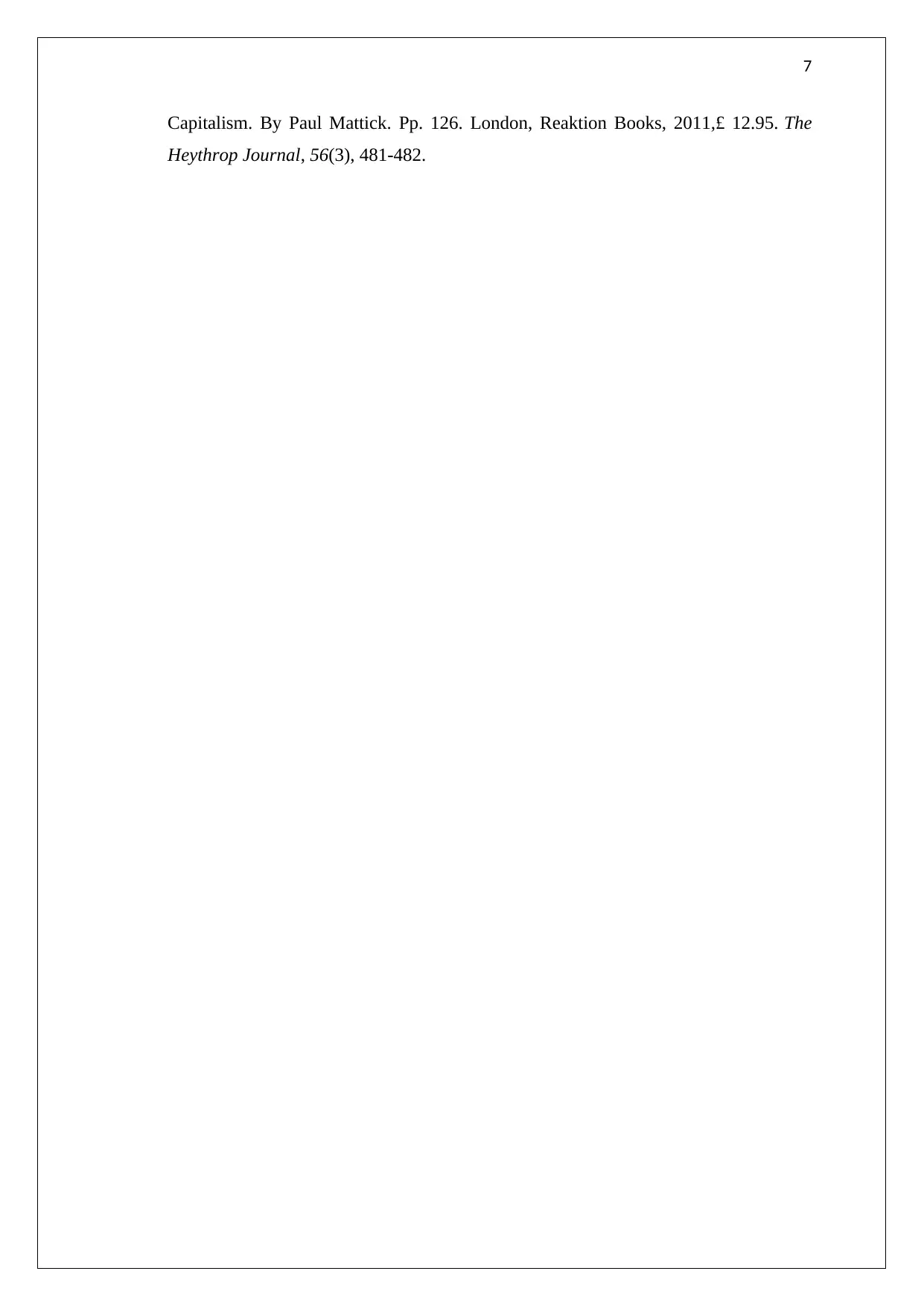
7
Capitalism. By Paul Mattick. Pp. 126. London, Reaktion Books, 2011,£ 12.95. The
Heythrop Journal, 56(3), 481-482.
Capitalism. By Paul Mattick. Pp. 126. London, Reaktion Books, 2011,£ 12.95. The
Heythrop Journal, 56(3), 481-482.
1 out of 7